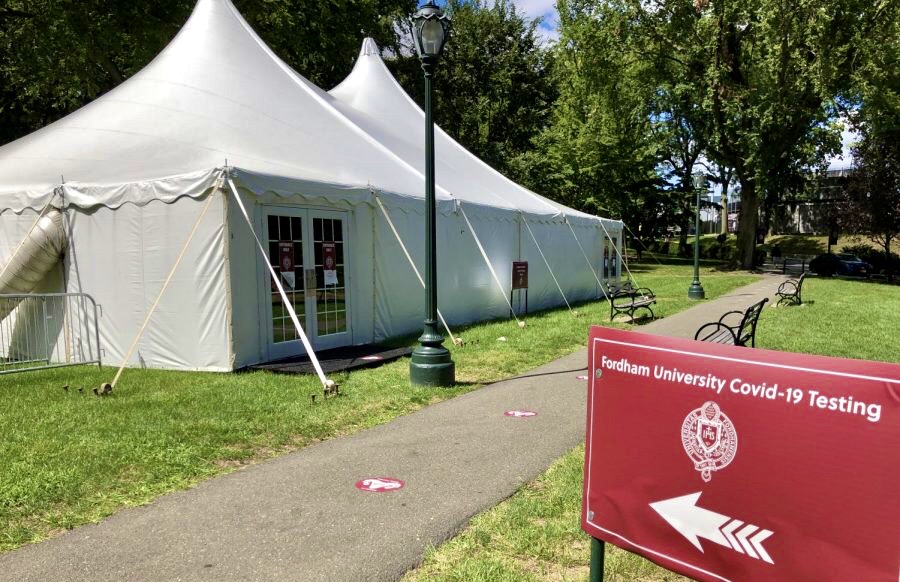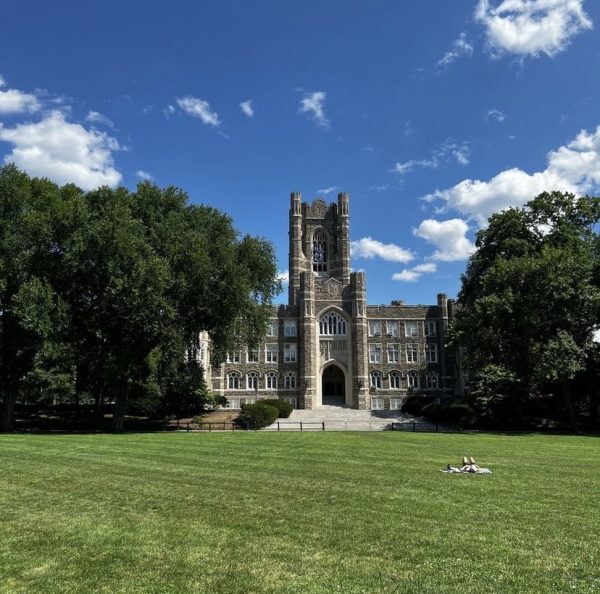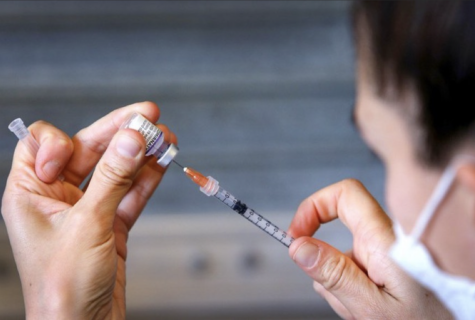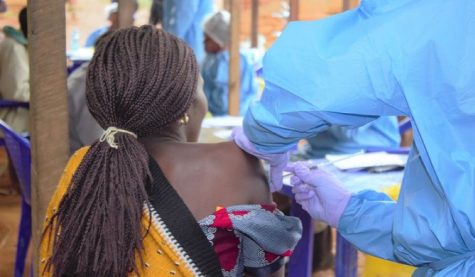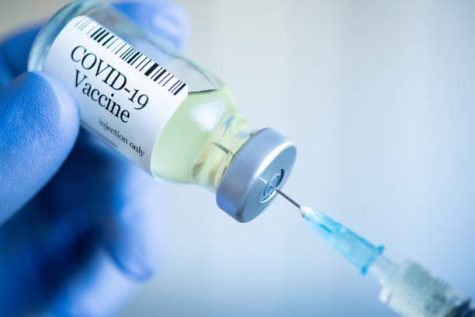Students, Faculty Concerned With Lack of Communication from University About Testing Procedures
Jack Roche, GSB ’22, said he just wanted to get tested for COVID-19. He had already gotten two tests at Fordham’s Rose Hill campus during the first two weeks of the fall semester, as everyone attending in-person classes at Fordham has been required to do. But, he wanted one more test on Sept. 16 because he was headed home for the weekend to visit family in Massachusetts and wanted to have peace of mind knowing that he wasn’t spreading the coronavirus to his family at home.
When he went to the tent outside O’Hare Hall for a test, Roche said he was initially turned away. Soon after, a security guard told him that Fordham’s policy was only to allow students to be tested twice before Sept. 23. After a phone call with Health Services, office manager Barbara Piliero directed him to a free clinic a couple of miles away in the Bronx. Soon after, he received an email from Piliero telling him that Maureen Keown, the director of Health Services at Rose Hill, had permitted him to get a third test.
“A lot of schools have been very transparent on what their plan is,” Roche said. “And it’s kind of frustrating as a Fordham student that I don’t even know the answer if I can get tested when I want to, not even any other precautions they’re taking, just a matter of if I can get tested.”
In the end, Roche got the third test. But the difficulty he found in getting clear answers on testing was not unique. Elizabeth Haywood, FCRH ’22, said she initially had a good experience with getting her first two tests of the semester but ran into complications when she arrived at the tent for her third. Haywood said the university only wanted to let her test again during the next phase of testing, which it is calling “surveillance testing.”
“The last time I got tested [Sept. 1], I was told I could go as many times as I wanted to as long as I waited at least seven days between tests,” she said. “But when I went again on Tuesday [Sept. 15] after waiting two weeks, they said that since I’d already been tested at least twice on campus, I could only be tested again through the surveillance testing or if I had symptoms and felt like I needed to get a test.”
The students’ experience suggests that there is a hole in the testing regime being used by the university. Fordham has all but wrapped up its initial round of testing, aimed at returning students and staff to campus safely, but has not yet moved on to the surveillance phase, which university officials say will be accomplished through random testing of students, faculty and staff.
According to Fordham’s COVID-19 FAQs, “Not every member of the community will necessarily be selected for this ongoing testing,” once the next phase of testing begins.
In an interview with the Ram, Keown said that Fordham was not turning students away if they needed or desired additional testing, even though Roche and Haywood say they were rejected.
“If [students] have completed their two required tests and several have had more than two tests, we are asking that they come back when the surveillance starts so we can finish up the students and employees who still need their second tests to meet the University requirement,” she said.
Unlike students, faculty are allowed to test every seven days if they so desire, according to the staff at the Fordham COVID-19 testing tent at Rose Hill.
As of Tuesday Sept. 22, Fordham has not communicated further guidelines on the next phase of testing and, specifically, how often students can get tested when the next phase of testing begins. The university has not said if students will only be able to continue to test if they are randomly selected for surveillance testing, or under what circumstances they can continue to test voluntarily.
Marco Valera, Fordham’s COVID-19 coordinator, declined requests for comment. However, Greg Pappas, associate vice president for Student Affairs, indicated that the decision and the timing of the move to random testing are “to be determined.” Keown had previously indicated that the next phase of testing would start this week. Pappas also said that how often students would be called in for random tests would be determined at another time.
Also, Pappas said that how often the university tests its students is dependent on testing capacity.
“We’re completing session two now, and then we’re gonna move to our next session of testing,” he said. “That session of testing is still to be determined and we’ll try to determine that in the next couple of days, and we determine that through consultation with the Department of Health.”
Pappas has since clarified that this decision will be made in the next week or so, per Department of Health recommendation.
“As we continue to offer on-campus testing throughout the months of October and November, the scope of testing will be determined in consultation with the DOH in the upcoming week or so, especially if we are advised to transition to random testing,” he said.
Pappas said that he and other testing supervisors are still in the process of figuring out if every student has received two tests, but he said that process should be complete by Wednesday. He also said that testing isn’t the only safeguard against COVID-19, even if it’s the most important one.
“The test is only as good as your behavior the minute after you took the test,” Pappas said. “So, at the end of the day, it’s not just testing upon which students and staff should rely. It’s everything — it’s social distancing, it’s PPE-wearing, it’s testing.”
The university’s lack of communication about the testing regime has raised some concern among students and faculty. Garrett Broad, an associate professor in the department of communication and media studies, said he understood Fordham’s judicious approach in communicating information to students because the university was waiting for guidance from New York state on how to proceed. The Ram reached out to Fordham’s outside epidemiologist, Dr. Shannon Magari, for comment, but she did not respond in time for publication.
Broad said he also recognizes that colleges and universities are in a difficult position, with many competing interests between students, parents, faculty and others.
That being said, he said that Fordham’s delays in getting information out has led to undue speculation and gaps in knowledge on the part of the student body.
“Classic health and risk communication 101 — be present early, be communicative early,” said Broad, who teaches strategic communication. “And I think, in some ways, the university did some really good work there, especially when we initially went online in the spring, communicating throughout the summer. But I also think there are moments where they probably could have been quicker, especially in terms of responding to some of the [concerns voiced] on social media.”
At the time of publication, the university’s dashboard shows there were 16 positive tests at the Rose Hill campus between Sept. 8 and Sept. 21, with the first positive tests appearing on Sept. 17. According to New York State’s higher education testing data, Fordham has had a total of 25 positive tests since Sept. 12. Additionally, the state’s website says that 57 Fordham students are currently in quarantine and another 15 are in isolation — this information is not available on the Fordham portal. No students, faculty or staff have been hospitalized as a result of their positive tests, according to the New York State department of health dashboard for Fordham University.
“I recognize that some of this is a heavy lift and requires some work, but I think in a situation like this, it’s never a bad idea to give more information,” Broad said.



































































































































































































